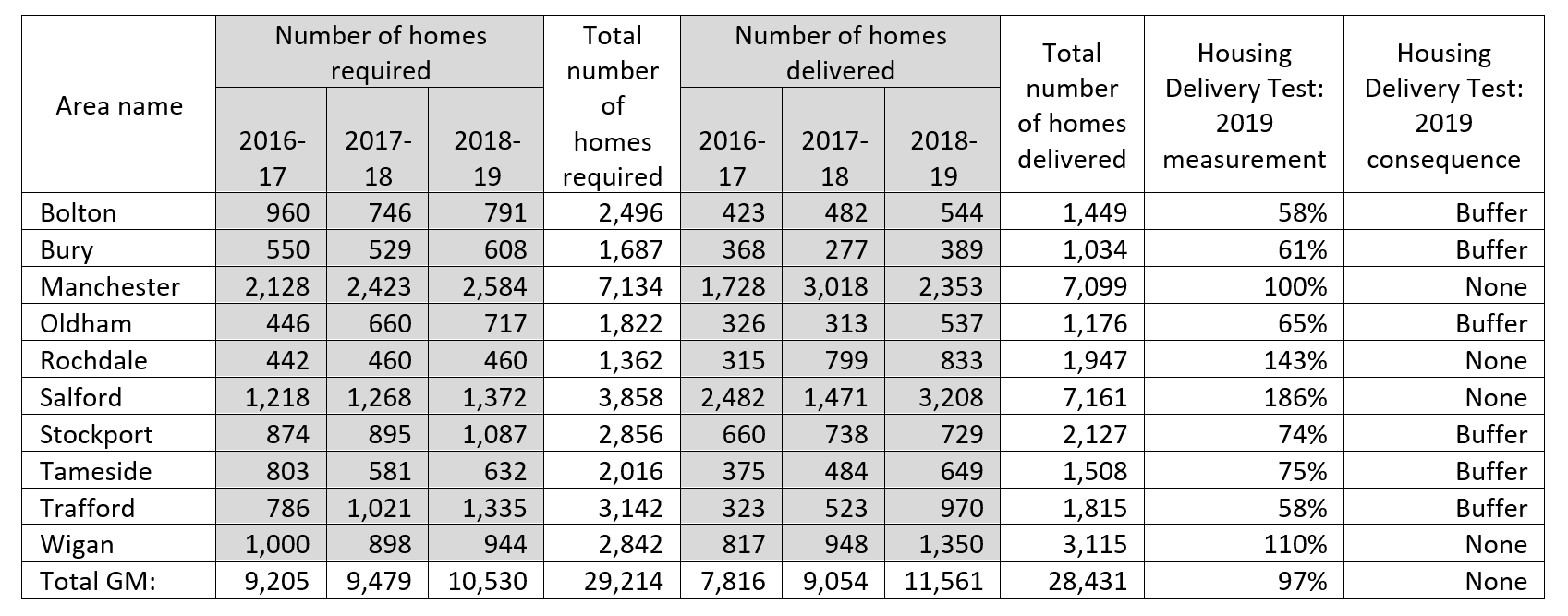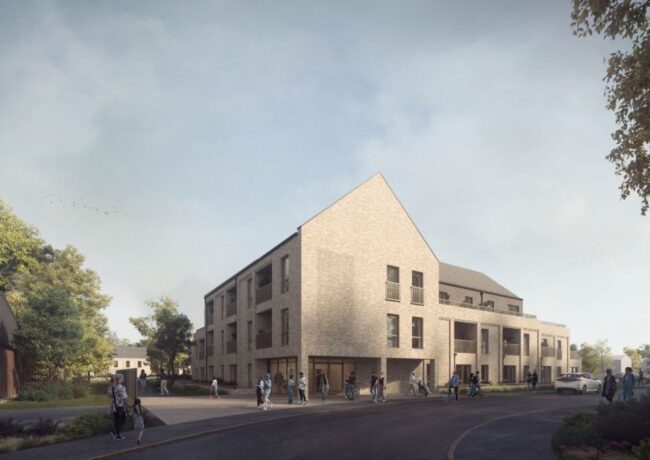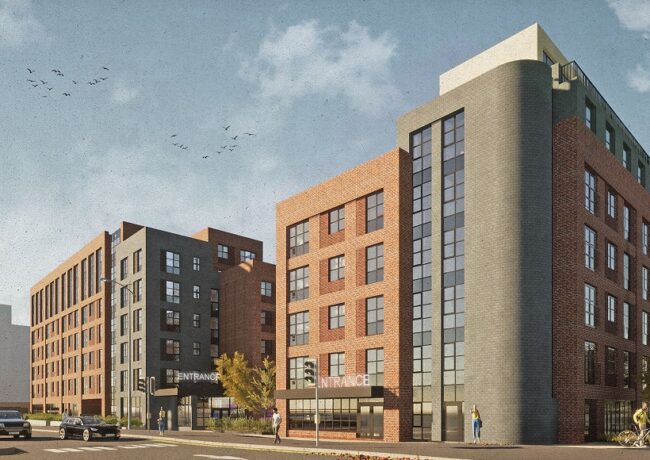Commentary
COMMENT | GM housing delivery – a divided city region
The introduction of the Housing Delivery Test as part of the July 2018 shake-up of the National Planning Policy Framework is having a positive effect across the Greater Manchester city region. On face value delivery rates across each of the 10 local authority areas has increased. However, a little more research shows that this does not tell the whole story, writes Hannah Walker.
The HDT requires local authorities in England to monitor the build-out rates of housing sites to ensure a supply of housing in each authority area is maintained. The HDT imposes a series of consequences for local authorities who fail to meet their housing requirements. Local authorities were not previously required to report their housing delivery numbers to the Government or be held accountable if housing needs weren’t being met. The test is having a positive effect because local authorities now realise that if they don’t meet their housing needs there are consequences and actions that they need to undertake to address this unmet need. Most significantly if the deficit is so severe it renders their housing policies out of date this can lead to unplanned housing developments which authorities are usually keen to avoid.
The latest findings of the HDT were published last week for the period 2016-2019. The findings for Greater Manchester are presented in the table below.
The results confirm the city region’s good news story of an overall increase in housing delivery, showing that:
- Delivery rates across the Region have increased, there were 7,816 new homes in 2016/17 versus 11,561 in 2018/19.
- Last year Greater Manchester delivered 1,031 dwellings above its total housing requirement.
- Greater Manchester, when viewed as a single market area, would score above the 95% delivery requirement set by national policy and would not be subject to any further action going forward.
Whilst housing delivery in none of the 10 Greater Manchester authorities fell below 45%, the mark below which housing policies would be deemed out-of-date according to national policy, the picture wasn’t entirely rosy.
- Only four of the 10 local authority areas – Salford, Manchester, Wigan and Rochdale – met the 95% housing delivery requirement
- Housing delivery in six authorities – Bolton, Bury, Oldham, Stockport, Tameside and Trafford – fell below the 85%. Requiring the addition of a 20% buffer to their five-year housing land supply targets.
Drilling further into the published results shows a bumpy trajectory ahead, with some authorities performing very strongly and others… less so. In summary:
- Salford has delivered more than double its housing requirement for 2018/19 which surpasses every other authority in Greater Manchester for the past three years and is more than Bury, Bolton, Oldham, Stockport and Tameside combined.
- Whilst still meeting 100% of its housing need, the number of homes delivered in Manchester has fallen by 665 homes from 2017/18 to 2018/19.
- Delivery rates in Rochdale significantly increased over the past two years with the borough delivering almost double its housing requirement and meeting 143% of housing need.
- The number of homes delivered in Wigan has also significantly increased over the past year, to 406 dwellings above its requirement.
- Despite nearly a threefold increase in delivery rates, Trafford was one of the worst performing authorities in Greater Manchester, meeting just 58% of housing requirement in the borough.
- Bolton mirrors the position in Trafford having only seen a marginal increase in delivery from 423 to 544 homes a year in the past three years.
- Lower housing requirements in Bury and Oldham means these authorities both performed slightly better than Trafford and Bolton, delivering 61% and 65% of their respective targets although delivery rates remain low.
- Tameside and Stockport both steadily increased delivery rates but not quickly enough to meet either borough’s housing need.
It is very telling that the strongest performing authority areas in Greater Manchester were Salford and Manchester, the two authorities with a strong pipeline of planning consents for high-rise apartments. Whilst it is the authorities around the M60, or should I say ‘suburban’ authorities, except for Wigan and Rochdale, that showed a deficit.
There is clearly an appetite and demand for urban living but looking forwards delivery of apartments will not meet the demand and need for a broader range of housing, including but not limited to extra care, affordable, family and higher value housing for more aspirational segments of the labour force.
The HDT demonstrates that housing delivery remains a challenge and there is potential for the situation to worsen from 2021 when the HDT requirement is based on the Standard Method rather than historic household projections. It also raises the question of whether the supply of urban sites is viable and suitable to meet the demand for new homes across the city region over the medium term (15 years +). A sound strategic plan is a must for the Manchester city region if genuine housing growth is going to be delivered and if Greater Manchester is to meet the housing needs of its population.
 Hannah Walker is associate planner in Barton Willmore’s Manchester office.
Hannah Walker is associate planner in Barton Willmore’s Manchester office.






It’s time to get the GMSF done and published so everyone can move on. It needs to be sold on the thousands of affordable houses being delivered and family homes being delivered for the mid range. The voices of the haves (those who have houses currently overlooking greenbelt) have been listened to, but the plan aims to deliver for all. Most importantly the plan will deliver for the thousands of what would be new homeowners under the plan who are a silent majority who seek to remain in their locale near their support network (family, medical etc) and careers rather than move away.
By Get GMSF Done
Not a hope in hell off seeing a strategic plan. Manchester planners have been working on it for 10 years but the local politicians see it as a hot potato to hot to touch. Burnham has had 4 years and achieved nothing.
By Just saying
Stockport and Traffords figures would have been much worse had it not been for their ability to count hundreds of Office to Residential conversions under permitted development rights, which will possibly start to dry up in the coming years.
By UnaPlanner
Of course delivery is ultimately down to the development industry, only this week has it has been announced again the scale of unimplemented permissions nationally. Councils should not be penalised if those who apply for permission don’t build. Two factual corrections; councils have for very many years had to report housing completions to government both through returns from Building Control and Housing Flow returns to MHCLG. In addition failure to deliver has also added 20% to 5 year supply requirements. The new things are the action plans and ultimately the presumption. Of course 6 or so of the GM authorities are already in a non-plan situation in the absence of a 5 year housing land supply. So the ultimate sanction of the presumption already applies. It also results in the perverse situation that an authority could demonstrate a 5 year supply but would fail the Housing Delivery Test (which is of course backward looking) and therefore be forced to release even more unacceptable land. While the HDT methodology is based on the 2014 household projections it has to be questioned when or who will challenge this legally once the 2018 are issued later this year. And these projections will be considerably lower. Quite how government will address this, a new methodology is anticipated, is yet to be seen. What fudge factors will then introduce to significantly increase the numbers to equal 300,000 per annum? And how will this affect distribution nationally?
By Informed planner
It’s time the GMSF was flicked into the long grass instead of being picked up in a plastic bag.
By Anonymous
Of course the HDT is based on historic projections too. All the evidence nationally and in GM suggest housing needs will be lower not higher. It seems unusual that for planning purposes the HDT uses outdated projections while all other service users will use 2016 and presumably 2018 when published. This is a classic example of putting politics before evidence and perhaps not the best way to plan. It also is why local communities feel they are having unnecessary development forced on them.
By Informed planner